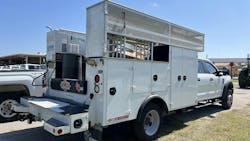Gasoline prices can be a bit of a roller coaster; all it takes is a touch more "instability in the Middle East" or a refinery problem such as a fire or hurricane to send them skyrocketing upward.
For managers with on-road assets from pickup trucks to haulers, it's wise to prepare for volatility. Merchants Fleet subject matter expert and consultant Tim Mundahl has six fuel economy tips that can help smooth out the wild ride of fuel costs.
1. Leverage telematics
"Real-time data can be one of the most effective tools for controlling fuel use," Mundahl says. "Telematics systems help fleet managers monitor vehicle performance, monitor driver behavior, track idling, and lead to smarter, more fuel-efficient driving patterns across the board."
Learn how L.A. County achieves sustainability with EVs
2. Prioritize PMs
A well-maintained vehicle is a more fuel-efficient vehicle. "Simple issues like underinflated tires, dirty air filters, or outdated oil can quietly drive up fuel costs," Mundahl says. "Regular, preventive maintenance not only extends vehicle lifespan, it ensures vehicles are operating at their most efficient."
3. Promote fuel-efficient driving
Everyone knows that driver behavior has a significant impact on fuel use. "Training drivers to reduce harsh acceleration, avoid excessive idling, and follow optimized routes can result in measurable savings," he says. "Many fleets are now using coaching tools that pair with telematics to support safer, more efficient driving practices."
4. Keep vehicles current to maximize savings
The age of the fleet matters. Mundahl recommends a solid Model Year Plan because it goes beyond just ordering. "It helps you pinpoint each vehicle’s Economic Useful Life and identify the best time to replace," he says.
"This strategic approach will help you boost fuel efficiency, cut maintenance costs, and increase resale value, delivering real savings while keeping your fleet running at peak performance."
Learn how to quantify the replacement decision
5. Use fuel management tools
Fuel card programs and digital dashboards provide essential visibility into fuel spending. Monitoring this data can help identify inefficiencies, flag unusual purchases, and provide benchmarks that inform broader cost-reduction efforts.
6. Mine data to build flexible future strategies
"Perhaps the most important shift is moving from reactive to proactive," Mundahl says. "Fleets that rely on consistent, clear data can better understand trends and make more strategic decisions. For example, knowing which vehicle types or routes are the most fuel-intensive can inform decisions about vehicle replacement or electrification over time."
About the Author
Frank Raczon
Raczon’s writing career spans nearly 25 years, including magazine publishing and public relations work with some of the industry’s major equipment manufacturers. He has won numerous awards in his career, including nods from the Construction Writers Association, the Association of Equipment Manufacturers, and BtoB magazine. He is responsible for the magazine's Buying Files.

